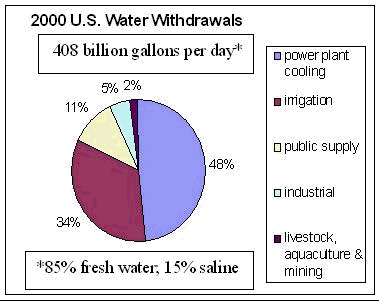Christian Parenti calls multiple crises “The Catastrophic Convergence” in “Tropic of Chaos, Climate change and the new geography of Violence”. The problem isn’t that calamities happen simultaneously, it’s that they compound and amplify one another.
Obviously drought reduces agricultural production. And what else?
War. In the Middle East, water is a source of conflict between Israel and its Arab neighbors, between Egypt and Sudan, and Turkey, Syria, and Iraq. Many have forgotten that the 1967 War was triggered by the water dispute between Israel and Syria over control over the Jordan River. Water conflicts add to instability in a region we depend heavily on for oil. Wars over water in the Middle East could lead to energy shortages again (not only does the Middle East have about 2/3 of the remaining oil, it’s the cheapest, easiest to pump light oil).
Nuclear war. if Israel starts a nuclear war, stratospheric ozone loss would affect food production globally up to 5 years
Energy loss: Geothermal, and thermal power plants that use fossil, nuclear and biomass fuels heat water to create steam to drive turbine-generators, and that requires huge amounts of water to cool the exhaust streams. Large amounts of water are used in fossil fuel production as well: 1) water is injected into oil wells to get more oil out and 2) in getting the oil out of tar sands.
Drought reduces the amount of hydroelectric power generated by dams.
Competition for water limits energy production already, a few examples: 1) Georgia Power lost a bid to draw water from the Chattahooche River, 2) the EPA ordered a Massachusetts power plant to reduce its water withdrawals, 3) Idaho has denied water rights requests for several power plants, 4) Duke Power warned Charlotte, NC to reduce its water use, etc (Hoffman)
Lack of energy and water:
- Groundwater not available: In a drought groundwater is “Plan B”, but with loss of energy from drought as well as declining fossil fuels, it’s too expensive to pull water up from deep aquifers. Long before the 2008 financial crash millions of acres were abandoned on top of the Ogallala Aquifer because the cost of energy was too high (windmills can only pull water up 20-30 feet deep, much of the Ogallala water is 300-500 feet deep or more).
- Desalination plants can’t convert as much sea water to fresh water.
- Less energy to transport water through pipes, canals, etc
Lack of energy to deliver & clean water and health: Plentiful, clean water, is the main reason we live past age 50 now
Death from heat or cold: not enough energy to run air-conditioners or heaters.
Source:
Allan Hoffman. Aug 13, 2004 The Connection: Water and Energy Security. Institute for the Analysis of Global Security.
Details from this article
Globally, commercial energy consumed for delivering water is more than 7% of total world consumption. Some specific examples follow:
1. Lifting ground water power needed = (water flow rate) * (water density) * (head) Lifting water from a depth of 100 feet at a flow rate of 20 gallons per minute, and assuming an overall pump efficiency of 50%, requires one horsepower.
2. Pumping water through pipes power needed = (water flow rate) * (water density) * (H+HL) where H is the lift of water from pump to outflow and HL is the effective head loss from water flow in the pipe. For example, moving water uphill 100 feet at 3 feet per second through a pipeline that is one mile long and 2 inches in diameter, requires 4.8 horsepower.
3. Energy needed to treat water Average energy use for water treatment drawn from southern California studies is 652 kWh per acre-foot (AF), where one AF = 325,853 gallons.
4. Energy needed for desalination. There is broad agreement that extensive use of desalination will be required to meet the needs of a growing world population. Energy costs are the principal barrier to its greater use. Worldwide, more than 15,000 units are producing over 32 million cubic meters of fresh water per day. 52% of this capacity is in the Middle East, largely in Saudi Arabia where 30 desalination plants meet 70% of the Kingdom’s present drinking water needs and several new plants are under construction. North America has 16%, Asia 12%, Europe 13%, Africa 4%, Central America 3%, and Australia 0.3%. The two most widely used desalination technologies are reverse osmosis (RO; 44%) and multi-stage flash distillation (MSF; 40%). Energy requirements, exclusive of energy required for pre-treatment, brine disposal and water transport, are: RO: 5,800-12,000 kWh/AF (4.7-5.7 kWh/m3) and MSF: 28,500-33,000 kWh/AF (23-27 kWh/m3).
U.S. water withdrawals in 2000 are shown below. Power plant cooling is the largest user, when total withdrawals (fresh plus saline) are counted. A 500 MWe closed-loop power plant requires 7,000 gallons per minute (10.1 million gallons per day). Of the 195 million gallons per day used in 2000 for cooling thermal power plants, 70% was fresh water, and 30% saline (only about 3% of this water is actually consumed through evaporation). Nationally, power plant cooling and agricultural irrigation each accounted for 39% of fresh water use.


One Response to Drought affects Survival in many ways